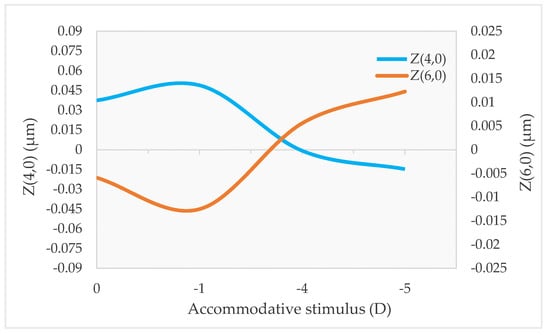High-order aberrations (HOAs) are optical defects that degrade the image quality. They change with factors such as pupil diameter, age, and accommodation. The changes in optical aberrations during accommodation are mainly due to lens shape and position changes. Primary spherical aberration (Z(4.0)) is closely related to accommodation and some studies suggested that it plays an important role in the control of accommodation. Furthermore, central and peripheral HOAs vary with refractive error and seem to influence eye growth and the onset and progression of myopia. The variations of central and peripheral HOAs during accommodation also appear to be different
depending on the refractive error. Central and peripheral high-order aberrations are closely related to accommodation and influence the accuracy of the accommodative response and the progression of refractive errors, especially myopia.
- aberrations
- accommodation
- refractive error
1. Introduction
2. Central HOAs and Accommodation
The quality of the retinal image change with accommodation has been already verified [7][8][9][10][11][12][7,8,9,10,11,12]. Atchison et al. [13] investigated in detail the changes of ocular aberrations of the eye as a function of accommodation. Monochromatic aberrations were analyzed in 15 subjects in 3 different levels of accommodation (0D, 1.50D, and 3.00D). Although the spherical aberration (Z(4,0)) became more negative with accommodation in eight subjects, there was not a clear trend in the amount and direction of changes for other aberrations. The sample size and substantial variability in aberrations between individuals may influence the results. Further studies were carried out and, although the variability between individuals was verified in several studies [8][9][12][14][8,9,12,14], it was shown that aberrations tend to become larger for a high level of accommodation (Figure 1) [8][9][10][11][12][8,9,10,11,12]. Some studies analyzed these variations only between the relaxed state and for a given accommodative demand, whereas others investigated different accommodative levels (Table 1). Root-mean-square (RMS) reaches a minimum close to a relaxed state, remaining constant from 0D to 3.00D of accommodation, and increases for high accommodative demands (Figure 1) (p < 0.05). [6][8][9][10][12][6,8,9,10,12]. In the relaxed state, most wavefront aberrations are approximately 0, except Z(4,0) (which is usually positive), and increase gradually for higher accommodative levels (from 3.00D) [6][8][9][10][12][6,8,9,10,12] with a relevant increase at 5.00D of accommodation (Figure 1) [10].
| Author (Year) | Eyes | Age (Years) | Refractive State (D) | Accommodative Stimulus (D) | Accommodation Stimulation Method | Measurement Method |
|---|---|---|---|---|---|---|
| Atchison et al. (1995) [13] | 15 | 0D, 1.5D and 3.00D | Aberroscope | |||
| He et al. (2000) [8] | 8 | 24–38 | SEQ: −2.00D–−5.56D | Between 0 and 6.00D in steps of 1.00D | Spatially resolved refractometer | |
| Ninomiya et al. (2002) [14] | 33 | 28.7 ± 4.4 | 0 and 3.00D | TDV | S-H | |
| He et al. (2003) [15] | 12 | 23–32 | SEQ: 0–−3.00D; Cil ≤ 0.25D | 0.25D and 5.00D | TDV | CTS |
| Hazel et al. (2003) [16] | 30 | 18–27 | SEQ: +0.50D–−6.00D; Cil < 0.50D | Between 0 and 4.00D in steps of 1.00D | NSL | S-H |
| Cheng et al. (2004) [9] | 76 | 21–40 | Sphere: +1.25D–−8.25D; Cil: −0.25D–−2.75D | 0, 3.00D and 6.00D | TDV | S-H |
| Gicquel et al. (2005) [17] | 28 | 20–25 | SEQ: −2.00D–+1.00D | Between 1.00D and 5.00D in steps of 0.50D | TDV | S-H |
| Plainis et al. (2005) [6] | 7 | 23–33 | Emmetropes; Myopes with sphere: −2.00D–−2.50D | Between 0D and 8.00D in steps of 1.00D | TDV | S-H |
| Buehren et al. (2006) [10] | 10 | 22–36 | Sphere: emmetropes +0.05D ± 0.19D; myopes −2.25D ± 0.85D Cil for both: −0.30D ± 0.45D |
0.17D, 1.00D, 2.00D, 3.00D, 4.00D and 5.00D | TDV | S-H |
| Wang et. al (2007) [18] | 20 | 18–32 | Sphere: −6.00D–+3.00D | Between 0 and −4.00D in steps of 1.00D | TDV | S-H |
| López-Gil et al. (2008) [19] | 24 | 19–29 | Sphere: −3.00D–+3.00D; Cil <1.00D | Between 0 and 5.00D in steps of 0.50D | TDV | S-H |
| López-Gil et al. (2010) [20] | 15 | 20–38 | Sphere: 0.38D–−3.06D; Cil: −0.38D ± 0.25D | Between 0.50D and 9.50D in steps of 0.50D | Badal | S-H |
| Fritzsch et. al (2011) [21] | 25 | 15–27 | Emmetropes | 0.22D and 5.00D | TDV | S-H |
| Yuan et al. (2013) [22] | 35 | 20–33 | SEQ: +0.50D–−2.38D; Cil <0.75D | 0.25D and 3.00D | TDV | S-H |
| Zhou et al. (2015) [12] | 22 | 18–28 | Sphere: 0D–−1.00D; Cil: −0.75D and 0D | Between 1.00D and 6.00D in steps of 1.00D | NSL | S-H |
| Wang et al. (2015) [11] | 10 | 0 and 3.00D | TDV | S-H |
2.1. Z(4,0), Z(6,0) and Accommodation
Z(4,0) is the aberration that shows the clearest trend with accommodation. When the accommodative system is relaxed, Z(4,0) is usually positive, and when accommodation is stimulated, it becomes less positive or more negative (Figure 2) [6][7][8][9][10][12][14][19][20][6,7,8,9,10,12,14,19,20]. However, the change from positive to negative values is not observed in every subject, because some individuals already present negative Z(4,0) in the relaxed state [6][8][6,8]. Moreover, the amount of this change varies between individuals [6][8][9][12][14][20][6,8,9,12,14,20]. The reason for these differences has not been explored but is likely due to the lens’s natural shape, which may not be the same for all subjects. Age also affects this tendency of Z(4,0) to become more negative with accommodation, being more evident in older subjects [19].
